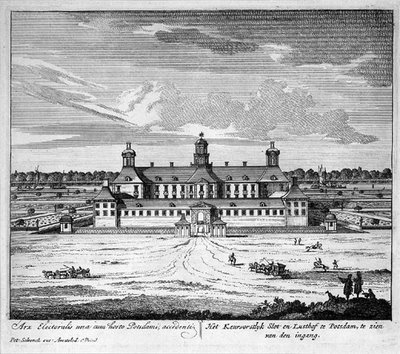The original palace buildings dated to the 1660s but the entire site underwent a major renovation during the mid-18th century when newly-crowned King Frederick II moved his royal court to Potsdam. The king hired Georg Wenceslaus von Knobelsdorff, a highly-regarded German painter and architect, to modernize the palace, both inside and out, and appointed him director of parks and buildings. City-wide renovations in the modern French style were underway, as was the construction of a summer palace, Sans Souci. It was Potsdam's awakening as a cultural center and literary figures like Voltaire visited the court. To this day, Potsdam offers some of the finest Baroque and Rococo architecture in all of Europe, though the Stadtschlosse is not one of them.

An engraving of the Potsdamer Stadtschlosse, circa 1720

An pre-WWII arial view of the palace, showing the full spectacle of von Knobelsdorff's 18th-century renovations, with the church of St. Nikolai near entrance gate
In the final days of World War II allied forces bombed Potsdam, striking the palace, but not destroying it entirely. Much of the building survived but in 1959 Communist leaders tore down all that remained, leaving only elaborate Rococo stables as evidence of the once-great palace.

The palace, April 1945
Since the 1990s several attempts were made to establish a rebuilding campaign, but each attempt was met with rejection by the governing Left Party, successor to the Socialist Unity Party that ruled East Germany until 1990. There was initial interest from a private investor who offered to fund the rebuilding in exchange for space to build a hotel, but the offer was declined. There were also preliminary excavations in the late 1990s during which parts of the original structure were found, along with artifacts like vases, but that start, too, was halted and the site was backfilled, abandoned yet again. The lone hope was a privately-funded reconstruction of the Fortunaportal, a replica of the original gate surmounted by a gilt figure of Fortune, that lead the way to the palace.

The palace's original entrance court, before the war

The new Fortune Gate, completed 2002
So it came as a tremendous shock when a record number of voters (even more than turned out for the last European Parliamentary election) turned out this month to approve a €120 million project that will rebuild the palace and reinvigorate a section of the city that has too long been ignored. Call it economics, call it pride - its a clear declaration of national identity and a reaffirmation to King Frederick II's quest for culture.
The approved plan is not an absolute replication of the Stadtschloss, but rather a recreation of its northern façade set in tune with a Modernist structure to the rear. Construction is slated to begin in 2008 with its new residents, the State Assembly of Brandenburg, moving in in 2011. It is early, though, and there is much to fall into place. A significant portion of funding must still be secured by private donations before ground is broken, but if the Fortune Gate is any indication, the coffers will overflow.
www.potsdam.de
No comments:
Post a Comment